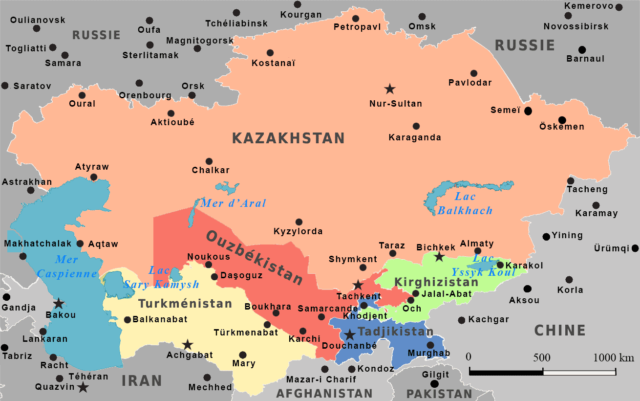Brussels and Beijing’s interest/competition in Central Asia

The first China-Central Asia Summit and the second EU-Central Asia Economic Forum highlighted Beijing and Brussels’ interests and competition in the region. Although both the parties have strategic interests, economic engagements, and diplomatic relations with Central Asian republics, China’s growing financial presence in Central Asia markets and Beijing’s Belt and Road Initiative might contrast EU efforts to strengthen partnerships with local actors.
Key Intelligence Findings
- The first ‘China-Central Asia’ Summit organised in Xi’an confirms the Chinese financial presence in the region and Central Asian republics’ dependence on Beijing’s economic support.
- China’s Belt and Road Initiative has facilitated its expanding economic presence in Central Asia, with significant investments in infrastructure projects, energy resources, and trade corridors.
- The second EU-Central Asia Economic Forum organised in Almaty underlined Brussel’s attempt to position itself as an alternative partner, particularly appealing to Central Asian countries seeking diversification after the beginning of the Ukraine conflict and the Western sanctions against Moscow.
- Both the EU and China compete for influence in Central Asia, particularly in areas of trade, energy resources, infrastructure development, and political alliances.
Context and Background
Central Asia occupies a geostrategic position and possesses abundant energy resources, making it a focal point for major powers. China’s BRI aims to secure economic interests, expand regional influence, and strengthen its global connectivity.
By releasing in 2019 the document titled The EU and Central Asia: New Opportunities for a Stronger Partnership, Brussels demonstrated its interest in the region and the strategy to promote stability, enhance cooperation, and secure its economic and political interests in Central Asia.
On May 18th-19th, 2023, Central Asian head of states visited the Chinese city of Xi’an to attend the first “China-Central Asia” Summit and meet with the Chinese President Xi Jinping. During the summit, the parties discussed a new package of investments worth about 3.7 billion dollars and implementing infrastructural projects to support the BRI.
During the same days, on May 18th-19th, 2023, in Almaty (Kazakhstan) was organised the second EU-Central Asian Economic Forum. During the event, EU representatives confirmed Brussels’ commitment to support Central Asia’s transition towards sustainable, socially resilient and climate neutral growth.
Implications and Assessment
The competition between the EU and China in Central Asia presents opportunities and challenges for both actors. China’s economic influence and investments create dependency risks and potential political entanglements for Central Asian countries. The EU’s emphasis on values and sustainable development offers an alternative approach but faces challenges in terms of resources and competing priorities.
The “China-Central Asia” Summit attests to Beijing’s role in Central Asia. Since the Belt and Road Initiative (BRI) launch, China has raised its role in Central Asia by investing huge financial funds into local markets and infrastructural projects.
Central Asian republics have fostered a substantial economic dependence on China, since Beijing accounts for a significant proportion of regional republics’ GDP and external debt. As an example, Tajikistan has a debt of 81,2 billion dollars to China (17% of GDP and 40% of external debt), while Kyrgyzstan’s debt to Beijing is 82,2 billion dollars (20% of GDP and 45% of external debt).
In the context of the Ukraine conflict and the Brussels- Moscow confrontation, the second EU-Central Asia Economic Forum in Almaty highlighted EU efforts to expand its activity and presence in Central Asia by improving connectivity projects and cooperation and reach a market of energy and mineral resources.
Central Asia has a strategic value because of its geographical location in the Eurasian geopolitical chessboard, which makes the region a ‘bridge’ between Europe and Asia. Since the collapse of the Soviet Union, Russia and the West have competed to include the region in their area of influence.
Moscow has a privileged relationship with Central Asian republics thanks to the recent historical past. Indeed, the Kremlin considers the area as part of its blizhnee zarubezhe (near abroad) and lebensraum (vital space), where the Russian Federation has attempted to extend its political, economic, and military ties through the Eurasian Economic Union (EAEU) and the Collective Security Treaty Organisation (CSTO).
In October 2022, Astana hosted the first “Central Asia – Russia” summit, where the participants agreed to intensify and deepen economic contacts between their countries and emphasised the importance of cooperation on a mutually beneficial basis. The event highlighted Russia’s interests in assuring its leadership in Central Asia and exploiting the region as a geopolitical leverage in the confrontation with the West.
Conclusion
The rivalry between the EU and China in Central Asia underscores the region’s critical importance and its immense economic potential. By offering an alternate market and trade partner to Central Asian republics, the EU can strengthen its standing, advance its ideals, and viably challenge China in Central Asia while helping the area’s lasting improvement.
To affirm its regional presence, Brussels should confront the intensifying Chinese financial activity and the Russian military and political presence in the area.
The Ukraine conflict, which caused the clash between Europe and Russia, and the confrontation between the People’s Republic of China and the United States in Asia-Pacific might influence Central Asia by pushing Beijing and Moscow to cooperate against Western interference in the area. As a result, this temporary Chinese-Russia collaboration might obstruct Brussel’s strategy in Central Asia.
Author: Giuliano Bifolchi
For further analyses and reports on Central Asia and foreign actors’ involvement in the region, do not hesitate to contact us at info@specialeurasia.com.
